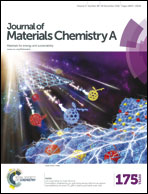Reconstructing ZnO quantum dot assembled tubular structures from nanotubes within graphene matrix via ongoing pulverization towards high-performance lithium storage†
Abstract
Transition metal oxides are very promising anode materials for high-performance lithium-ion batteries (LIBs). However, they experience large volume expansion upon cycling, resulting in electrode pulverization and poor cycling stability. Here, we demonstrate a rational design and synthesis of graphene-wrapped ZnO nanotubes, and graphene oxide nanosheets in the reaction form a “soft” sealing layer to confine the crystal growth within a small space, which enables the nanotubes to be tightly bound with the graphene matrix. It is interesting to find that electrode pulverization upon cycling is not so much a drawback but a blessing in disguise, which reconstructs the starting nanotubes into quantum dots with an average size of ∼2.3 nm within the graphene matrix in the form of a tubular structure. The formed quantum dots not only provide a high contact area with the electrolyte but also shorten the solid-phase ion diffusion. Meanwhile, the graphene nanosheets are still tightly bound with the quantum dot assembled tubular structure, which can accommodate volume change and facilitate efficient electron transport and lithium-ion diffusion in electrodes. When used as an anode in LIBs, they demonstrate excellent cycling stability with a high reversible specific capacity of 891 mA h g−1 over 1000 cycles at 2000 mA g−1.


 Please wait while we load your content...
Please wait while we load your content...